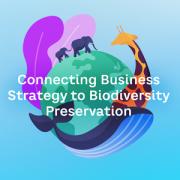AMPLIFY VOL. 36, NO. 3

Human activity is driving biodiversity loss at a scale so large and rapid that we are in the midst of the sixth period of mass extinction. In fact, since 1970, we have seen a nearly 70% drop in animal populations, and more than a million species are under threat of extinction.1 This pressure on nature is compounded by rising global temperatures due to climate change.2
The topic of biodiversity loss has, until recently, been mostly of concern to scientists. Business leaders are not well informed about biodiversity, as P.J. Stephenson and Judith Walls discussed in their recent Amplify article, “A New Biodiversity Paradigm for Business.”3 Nevertheless, biodiversity loss is a serious business issue. Business activity depends on and impacts biodiversity both directly and indirectly. Biodiversity represents both a source of business risk and an opportunity for value creation.
Biodiversity is the variety of living organisms from genes to species to ecosystems.4 Declines in biodiversity negatively affect ecosystem services — services that the Earth provides “for free” such as food; water and raw materials; basic soil formation and photosynthesis; regulation of climate, air, and water; pollination of crops; and cultural value through beauty, spirituality, and recreation. All these affect business operations.
Businesses and policy makers are paying increasing attention to biodiversity. At the recent Conference of the Parties (COP 15) in Montreal, Canada, the Global Biodiversity Framework called for extensive conservation and restoration of land and water ecosystems. The framework also places demands on business with goals to reduce risks from chemicals and pesticides by 50%, phase out subsidies that harm biodiversity, cut global food waste in half and reduce overconsumption, and raise financial flows for developing and vulnerable countries. It will require large transnational companies and financial institutions to monitor and disclose their risks, dependencies, and impacts on biodiversity — not only in their own operations, but also across supply chains and portfolios.
In short, the framework highlights the important role of business to maintain, protect, and regenerate nature. Businesses can address biodiversity loss through nature-based solutions that also help mitigate climate change and meet the United Nations (UN) Sustainable Development Goals (SDGs). Nature-based solutions are actions taken to “to protect, sustainably manage, and restore natural or modified ecosystems that address societal challenges effectively and adaptively, simultaneously providing human well-being and biodiversity benefits.”5
Business is slowly moving in the direction of tackling biodiversity loss. Plenty of voluntary, nonfinancial reporting processes already include aspects of nature-related disclosure. As pressure on companies rises to address the risks to biodiversity, businesses will need to develop ways to measure, monitor, and manage their impact on nature.
Businesses face several challenges when embedding biodiversity into their strategies. First, they typically lack knowledge about biodiversity and how it relates to business activities, a gap that is difficult to overcome as business education rarely includes biodiversity. Second, financial, technical, and human resources to address biodiversity issues can be difficult to find. Third, although nature-based solutions can help combat climate change, there can also be trade-offs between what benefits climate change and what benefits biodiversity.
In This Issue
This issue of Amplify focuses on practical solutions for businesses seeking to address biodiversity loss and regenerate nature. We invited authors to explore two questions. First, how can businesses address current failures to protect biodiversity? Second, what knowledge and resources are necessary to change business activity that impacts the health of ecosystems?
The authors seek to answer these questions and help businesses in various industries put solutions in place. The first group of articles discusses using language to bring nature to the forefront of business decisions, leveraging stakeholder engagement to encourage democratic approaches to biodiversity action, and using circular economy (CE) principles to address biodiversity. The second group of articles centers on industry examples to highlight trade-offs between climate change solutions and biodiversity.
Linking Biodiversity to Business Action
Anna Heikkinen, Ari Jokinen, and Johanna Kujala kick off the issue by exploring how nature positive language provides a useful instrument to drive business action on biodiversity issues. They examine how language is critical for developing nature-based stakeholder engagement and illustrate how it can motivate companies to take actions on biodiversity. The authors conclude with descriptions of the benefits nature-based stakeholder engagement can have for businesses, local communities, and the environment.
Next, Simon Pek and Nicholas Poggioli look at how businesses can learn about biodiversity issues and incorporate them into effective strategies through mini-publics. Mini-publics gather a wide range of stakeholders to deliberate and provide recommendations on addressing an issue. Pek and Poggioli describe how mini-publics can be initiated, their key components, and the benefits they offer for business strategy formulation and implementation. They also look at how businesses can implement mini-publics in a responsible manner and ensure a deliberative democratic process.
In our next article, returning Amplify authors Paul Dewick and Joseph Sarkis emphasize the important role the circular economy has in protecting biodiversity. They begin by presenting business strategies for circularity and extending these to consider biodiversity. CE business models draw attention to the importance of reducing waste and pollution, reusing and recycling materials, and regenerating natural systems. The models focus on the strategies of narrowing, slowing, closing, and regenerating/restoring and show how circularity can advance biodiversity protection. Dewick and Sarkis provide practice-oriented guidelines for implementing circular strategies and discuss how enabling factors like IT support, stakeholder engagement, and measurement are important for facilitating circular strategies that protect biodiversity.
Business & Biodiversity in Practice
In his article, Rafael Sardá examines the potential of offshore wind farms and the challenges of balancing climate change mitigation with biodiversity protection goals. Significant advances in technology and expanded government support have led to increased development of offshore wind farms. But Sardá cautions that large-scale renewable energy projects should be planned and implemented with biodiversity considerations embedded, so that one environmental goal is not sacrificed for another. He proposes a way to balance protecting marine areas with promoting nature positive strategies.
Finally, Stefania Pizzirani, Robert Newell, Alesandros Glaros, Saeed Rahman, and Lenore Newman explore vertical farming as a pathway to biodiversity conservation. They provide three guiding principles for how vertical agriculture can conserve biodiversity: (1) diversification in produce, (2) localized, decentralized farming, and (3) integration with other social, economic, and physical systems. The authors then apply these principles in practice across several business models in vertical agriculture. They conclude by describing how management practices, complementary technologies, and policy collaboration are key to successful vertical farm implementation.
Protecting and regenerating nature is a complex process that requires businesses to collaborate with local communities, government authorities, and nongovernmental organizations. This issue of Amplify shows how businesses can link their practices to biodiversity conservation and regeneration, with examples of how this might look in two industries.
References
1 Alkemade, Rob, et al. “Living Planet Report 2022 — Building a Nature-Positive Society.” WWF, 2022.
2 Aldunce, Paulina, et al. “AR6 Synthesis Report: Climate Change 2023.” Intergovernmental Panel on Climate Change (IPCC), 2023.
3 Stephenson, P.J., and Judith Walls. “A New Biodiversity Paradigm for Business.” Amplify, Vol. 1, No. 5, 2022.
4 Matthews, J.B. Robin, et al. (eds.). ”Annex VII: Glossary.” In “IPCC Sixth Assessment Report — Working Group 1: The Physical Science Basis.” Intergovernmental Panel on Climate Change (IPCC)/Cambridge University Press, 2021.
5 Seddon, Nathalie, et al. “Getting the Message Right on Nature-Based Solutions to Climate Change.” Global Change Biology, Vol. 27, No. 8, April 2021.





